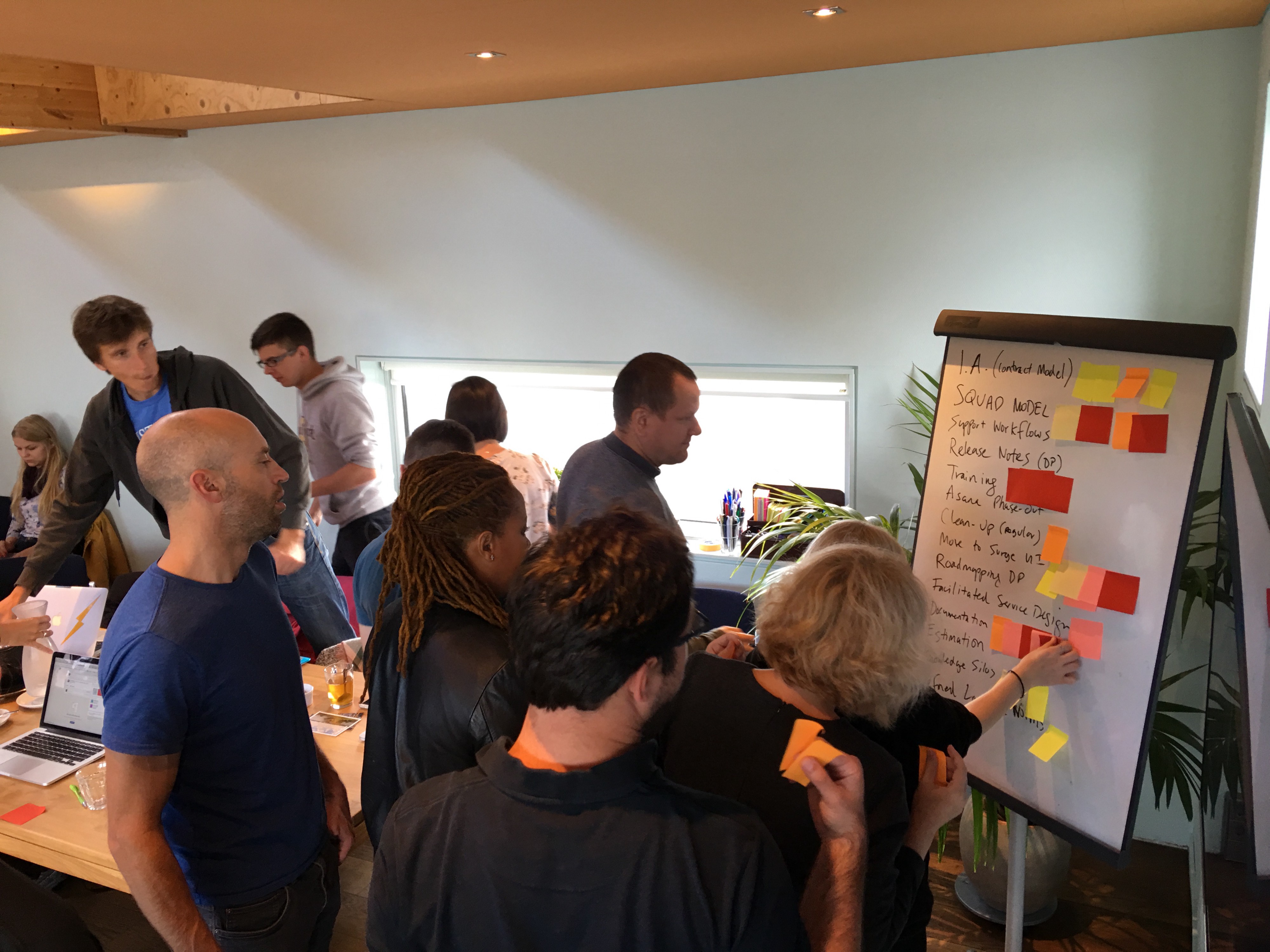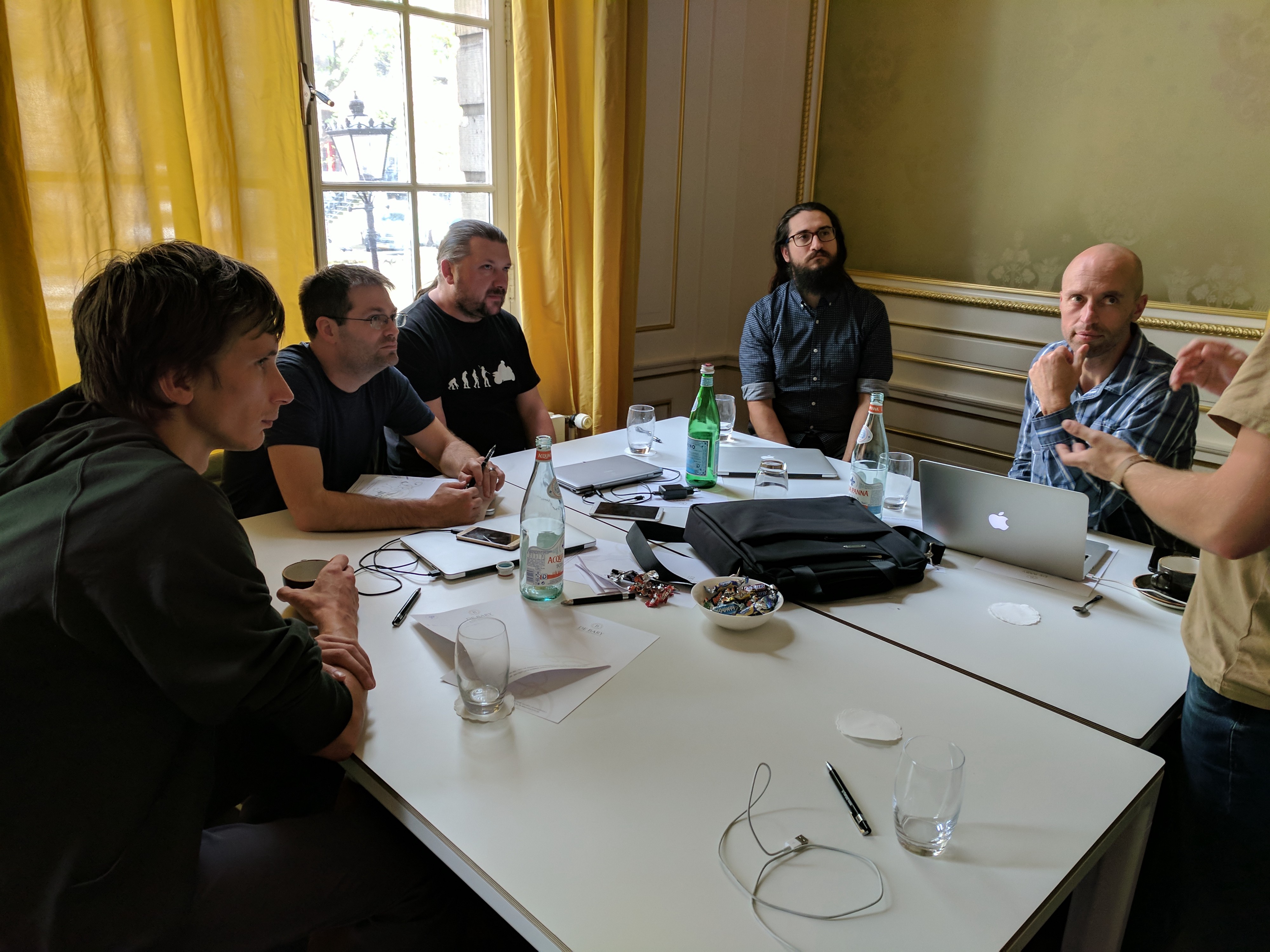Planning A Remote Team Summit

Planning A Remote Team Summit
It is essential for distributed teams to have face to face time. We try to get the entire department to get together at least once a year. In general, smaller groups within our department also get together from time to time to collaborate on specific projects as well. If you read about organizations that do remote work well, they organize one or more team summits/retreats a year.
The team enjoying the rare chance to use post-its in person
Value of Distributed Team Summits
At our summits we work through pain points in our processes and structure, we build trust, and collaborate taking advantages of some of the in-person advantages inherent to being face to face… For example whiteboards (we miss you), post-it-notes, sketches, and more. The value of the summit will long outlast any specific decision or activity. The team will walk away more confident in having challenging discussions, reaching out across organizational boundaries, and assuming best intentions first when issues arise. The most valuable part and the prominent goal of bringing everyone together is team bonding and building trust.
Summit Planning
Planning required for a proper summit shouldn’t be underestimated. At OGE, we put together a small workgroup that met weekly to plan the event. The group developed a schedule, planned sessions, activities, and assigned follow up tasks to specific people. Our workgroup used slack, confluence, and weekly video chats to plan our summit.
Logistics:
The logistics around planning a summit for a distributed team summit gets increasingly complicated as your team grows. Early gatherings might start as simple as flying a handful of people and booking hotel rooms. As an organization expands, it will require coordination among dozens of people across time zones, countries, and schedules.
Start planning early:
- Finding dates for your event that work across dozens of people and countries holidays will be a challenge.
- Many folks may need visas and you will want to start on this with plenty of time (OGE, unfortunately, ended up having a Visa issue preventing one person from attending this year)
- Avoid high hotel and airfare costs by being able to book well in advance
Travel Help:
- Depending on your organization it may be helpful to coordinate flights, hotels, etc.
- Also, it might be easier to let some things be handled ad-hoc and allowing for expensing ad-hoc costs (ex: travel to/from the Airport)
- A reminder on guidelines around expensing will help put people at ease and avoid unexpected expenses
- Depending on the situation folks might need help with Visas (ex: letters from businesses requesting their travel for an event, proof of hotel accommodations, etc.)
- Booking blocks of rooms at hotels or whole Airbnb houses can help with cost and logistics by keeping the group close to each other and the venue
- Booking a venue, when small you might meet at a local office, but as you grow a local office likely can’t handle an influx of the full international team
Day to Day help:
- Having someone from the local team available to help with planning can be very valuable
- Coordinating lunches can save a lot of time in the schedule. (self-exploring, forming groups, and finding lunch in an unknown city lead to lots of missed afternoon meetings)
- As there will likely be needs for some communication and standard work, planning on reliable and fast internet connections is highly recommended
- Some recommendations on dinners, things to do, how to use local transit, etc

Discussing our DevOps challenges in person
Communications, keeping everyone up to speed
It is important to communicate about your event to various people in the organization before, during, and after the event. I will cover some essential communications to keep in mind.
Prior to the event
Exec / Budget: This communication has to happen far before any event. This happens as you build a team and invest in a distributed workforce. If a growing budget expense for an international summit isn’t understood as necessary all the way up the organization, your group probably shouldn’t be building an international team. Make sure folks know while sometimes you save on salary by not hiring everyone in expensive markets or having office space for all employees there are some overhead costs, such as increased travel budgets to ensure the team can get together from time to time.
Stakeholders and Partners: Let stakeholders know they will have limited access to the team and deliverables likely won’t be released (or make progress) during the event. Sharing a bit about why it is necessary for a distributed team to work on processes, planning, and collaboration in person from time to time. Let folks know it is coming up as soon as you have dates. Follow up sending reminders immediately before the event. The reminder email should include clear guidelines on expectation on what work will or will not happen that week. Also, officially cancel any regularly scheduled meetings, and explain how to raise any emergency issues that may arise (phone numbers, SMS, and contact info for backups that might not be able to attend the event, etc.).
Internal team: set expectations that we are there to communicate and work together, and to not be on laptops on slack and in remote meetings much during the week. The costs and value of getting together are too valuable to end up spending it as a regular week. Share travel tips, schedules, a map with notable locations, and contact info to a local person to help resolve any unexpected travel issues.
During the Event
Stakeholders and Partners: Send a quick reminder as the event starts. Folks sometimes enjoy seeing some photos or updates as the event occurs.
Internal team: If any of the schedule plans change make sure to share with everyone. Makes sure folks have a way to access changes when away from venue internet. Either in person or async during the event take little check-ins to make sure the event is going well, the discussions are valuable and that nobody is struggling with some unexpected challenge related to travel, accommodations, etc.
After the Event
Everyone: We have both slack and workplace where the organization shares news. The team should share a write-up with the company explaining what happened, where, and some updates on things you did. Share some photos, let other departments know what your team is up to and celebrate a bit of the rate time you get together.
Internal team: follow up on action items, plans and re-enforce decisions that were made at the event.
Setting an Event Format
There are many formats and ways to plan events, so I won’t try to cover them all. Instead, I can say it is good for the group planning the event to find some structure they can agree on. Then work together to roll it out. Our planning group read The Advantage and loosely followed some of its guidelines as well as some of our ideas to plan the event. I think any book or document can help guide planning towards a successful event. In the end, our high-level agenda looked like below having topic theme focuses each day, with the last day planned to follow up on topics and questions that came up during the event.
- Day 1: Trust
- Day 2: Method
- Day 3: Impact
- Day 4: Innovation
- Day 5: Acceleration
Was the summit a success?

The primary meeting room
How did our event go? I think it went well and accomplished many of our goals. Everyone came away saying it was a great event and that we should do them more often. We sent out a survey to all the attendees and scored higly across the board. For a bit, more details on our most recent event read our Distributed Teams Amsterdam Summit Recap.
